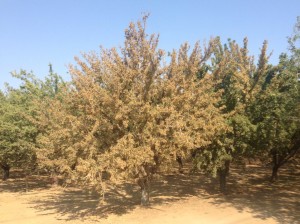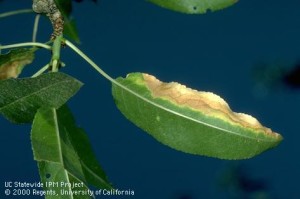Written by Franz Niederholzer, UC Farm Advisor, Colusa/Sutter/Yuba Counties and Joe Connell, UC Farm Advisor, Butte County
In the last month, several PCAs and/or growers have reported trees in almond orchards in the south Sacramento Valley with symptoms similar to those of almond leaf scorch (ALS) — a disease caused by the bacterium Xylella fastidiosa. Five of the six fresh leaf samples subsequently submitted to a lab for ALS evaluation tested positive for Xylella fastidiosa. Varieties that appear more susceptible in the field include Peerless, Sonora, Winters, Livingston, and Wood Colony.

Almond leaf scorch spreads within trees and will reduce tree vigor and crop yield long before the tree succumbs. The bacteria live in the xylem, the water transporting structures in plants, and reduce the flow of water to leaves. Leaf tissue dies when xylem plugging due to bacteria presence results in insufficient water arriving at the leaf margins. Scorch symptoms first appear in a branch, scaffold, or portion of the tree, but will subsequently spread to affect the entire tree (see Photo 1). The rate of symptom spread from first visible to covering the entire tree can be slow (years) or fast (months). Leaf symptoms resemble salt burn, but leaves with ALS show a bright yellow band between the brown, dead tissue and the green, living tissue (see Photo 2) particularly early in summer. After harvest, symptoms are less distinct and more closely resemble salt damage. With salt damage, there is usually just healthy, green tissue and dead, brown tissue without the yellow margin between the healthy and dead tissue.

ALS is vectored into the trees by xylem-feeding insects such as spittlebugs, leafhoppers, and sharpshooters, with sharpshooters as the most probable vector for almond. Common annual weeds in the orchard can be sources of infection. At this time, there is no evidence that infected trees are the source of bacteria to infect other trees but sharpshooters feeding on infected trees can infect annual weeds and sharpshooters feeding on the infected annual weeds can infect additional trees in the orchard. Irrigated pasture, weedy (grasses) alfalfa and permanent cover crops are the most common habitat for sharpshooters in almond growing regions of California.
Click HERE to visit the UC IPM ALS information, including options for eliminating infection sources within an orchard and management options once the disease is detected in an orchard.
How do you know if an orchard actually has ALS? Click HERE to see an article on tests and labs for detecting Xylella fastidiosa in grapes — where it causes Pierce’s Disease. The same testing practices and labs listed in that article can be used for testing almond leaves for ALS. The labs listed in the article are currently taking samples for Xylella fastidiosa detection. Cost per sample runs from approximately $150-400 depending on the lab and the number of tests run.


Salt Burn v/s Leaf Scorch - The Almond Doctor
August 2, 2014[…] The Almond Doctor, 2013: Almond Leaf Scorch. […]